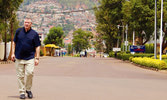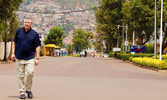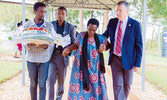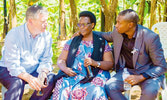Allan Thompson reflects on Rwanda reporting 25 years later - April 18, 2019
BY ALLAN THOMPSON
It has been 25 years since the tiny African nation of Rwanda slid into the abyss. The killings happened in broad daylight, yet many of us — individuals, media outlets, entire governments — turned away, or failed to grasp the unfolding events.
And that includes me. As a reporter covering foreign affairs issues for the Toronto Star at the time, I somehow didn’t grasp what was happening in Rwanda and remained as oblivious as many of my colleagues. I will forever be ashamed.
When human beings are at their worst — as they most certainly were in Rwanda during the 1994 genocide — the world needs the institutions of journalism and the media to be at their best. Sadly, in Rwanda, the media fell short.
Twenty-five years after the Rwanda genocide, as similar tragedies continue to unfold today, there is still much to learn about the role that media plays when mass atrocity events threaten.
For that reason I travelled to Rwanda to take part in ceremonies marking the 25th anniversary, to reconnect with friends there and to promote my new book on media and genocide. It was a remarkable return to a country that I have visited nearly 20 times since 1996, as a reporter, as a researcher on the role of media during genocide and as a university professor.
My week in Rwanda for the 25th anniversary events was an emotional roller coaster. It is hard to express how powerful it was to be in the national soccer stadium on April 7. Nearly 30,000 people were jammed into the stadium that became a place of refuge during the genocide, where thousands sought sanctuary under the UN’s protection from the machete-wielding crowds out in the streets.
During the evening vigil, the president lit the first candle in the centre of the stadium, then all around, in a kind of wave spreading through the crowd, people lit candles or held aloft their cell phone flashlights, a sparkling moment of hope in the darkness.
Confronted by Rwanda’s horrors in 1994, international news media at times turned away, or muddled the story when they did pay attention by casting it in a formulaic way as anarchic tribal warfare rather than an organized genocide. Hate media outlets in Rwanda played a role in laying the groundwork for genocide, and then encouraged the extermination campaign.
The lessons of Rwanda, in some respects a textbook case, should have been clear. But a quarter century later, these are lessons that we still struggle to absorb.
The global media landscape has been transformed since the 1994 Rwanda genocide. We are now saturated with social media, frequently generated by non-journalists. Mobile phones are everywhere. And in many quarters, the traditional news media business model continues to founder. Against that backdrop, it is more important than ever to examine the nexus between the media and the forces that give rise to mass atrocity.
And at times, it seems that those who abuse the power of media and communications to demonize and divide get the upper hand, echoing on new social media platforms the same hate and prejudice as that broadcast all those years ago by the Rwanda hate radio station RTLM.
Social media tools can be used to inform and engage, but also - in an echo of hate radio in Rwanda - can be used to demonize opponents and mobilize extremism. We are left with many troubling questions, still unresolved despite the passage of time since Rwanda.
My new publication from CIGI Press – Media and Mass Atrocity: the Rwanda Genocide and Beyond – documents an effort to revisit the Rwanda case study while also casting forward to other scenes of mass atrocity where media have played a role.
The collection of papers – 27 chapters in all – begins with a foreword and introduction from one of the actors in this drama, retired Canadian general Roméo Dallaire, who was the commander of the doomed United Nations peacekeeping force in Rwanda. In his introductory chapter, Dallaire argues that media can be used as a weapon by combatants in a conflict but should also be deployed by those who seek to prevent or staunch the fighting. Dallaire’s focus is on how the UN mission that he commanded failed to use news media tools effectively even as proponents of the genocide dominated the airwaves with their hate radio messaging.
The Rwanda genocide sparked the usual calls of “never again” and yet, in the years since, the world has witnessed numerous mass atrocity events that could be called “echoes of Rwanda.” The collection applies a media lens to the cases of Darfur, Central African Republic, the Yazidis, Syria, Myanmar and South Sudan while harkening back to Rwanda.
The impact of social media as a new actor is examined through chapters on social media use by the Islamic State, in Syria, and in other contexts across the developing world.
Media and Mass Atrocity: the Rwanda Genocide and Beyond questions what the lessons of Rwanda mean now, in an age of communications so dramatically influenced by social media and the relative decline of traditional news media. And in the end, there are still far more questions than answers.
In my own experience, I was able to contribute to international awareness of the events in Rwanda – albeit years after the fact – by documenting the case of the video footage captured on April 11, 1994 by British journalist Nick Hughes, showing the deaths of two of the early victims of the genocide. Years later, and with the help of others, I was able to identify those who had been killed in the famous footage – Gabriel Kagaba and Justine Mukangango – and to tell their story through the recollections of family members who survived. The enormous response to the original Toronto Star story about the Hughes footage made me realize that part of what had been missing from the coverage of events in 1994 was a human face.
The most powerful journalism is about people. As journalists, we sometimes feel we have succeeded if our work brings those people to life. For those who report on conflict and mass atrocities, perhaps we have achieved something if we can convince people to identify with those who have perished, to feel some connection and responsibility and most important, to learn.
And the most powerful moment of my return journey to Rwanda was the chance to spend April 11 with the family of Gabriel Kagaba, the patriarch who was slain on the street in Kigali all those years ago, a death caught on camera.
We placed a single red rose on the spot where 25 years ago to the day, two people among the hundreds of thousands of victims of the 1994 Rwanda genocide lost their lives.
The Kagaba family returned to the street in Gikondo where the fabric of their world was torn asunder by the brutal murders of a father and sister in the first spasms of the Rwanda genocide.
As far as I know, the Hughes footage is one of the only instances of a killing being caught on camera by a journalist during the genocide. That fact in itself speaks volumes. There just weren’t enough of us there to capture these events, to make the world understand or care.
The grainy video shows Gabriel and his daughter Justine kneeling on the dirt road among the bodies of others that had already been slain. Gabriel is waving his arms, in prayer. Moments later, men armed with clubs and farm tools step forward and beat Gabriel and Justine to death.
They were murdered in front of the whole world, but no one knew their names, or seemed to care.
Years later, I went back to Rwanda to find witnesses to that killing and to identify the victims in the famous footage, who had up to that point been anonymous. That story, “The father and daughter we let down” can still be found online in the Toronto Star.
A quarter century after those killings, I had the honour of spending the day Thursday with Rosalie Uzamukunda - who lost her husband Gabriel and oldest daughter Justine that day.
Since I documented her family’s story for the Toronto Star in 2009, Rosalie and I have kept in touch. I try to support them the best I can and I see Rosalie and the rest of the family whenever I’m in Rwanda. I’m Facebook friends with her youngest son Isaac (who was born two months after the death of his father and elder sister) as well as sisters Violette and Yvette. There are also two older sisters, Josephine and Debra and a brother, Charles. In 2017, I took our son Laith to visit as well and since then, the family in Rwanda always asks for him. And my wife Roula always sends gifts for them as well.
After spending some time at the memorial, Rosalie insisted on once again visiting the street in Gikondo, where the killings took place, and to see the bulldozed lot where their family home once stood. To compound the family’s struggle, the simple but functional home that was Gabriel Kagaba’s legacy to his wife and children had been built on a flood plain and would eventually crumble and be swept away, leaving Rosalie with nothing.
Later we made the long drive to Rosalie’s rented home in Kabuga, a simple red brick structure with a small living room, kitchen and two bedrooms. There is a little patch of lawn beside the house, which backs onto a banana grove. Rosalie pays close to $100 U.S. per month in rent, which is a burden compared to the other home, which she owned.
Daughter Violette, the first member of the family I met when I showed up at their door as a reporter all those years ago, was the one who rose to speak on behalf of her relatives. As is the custom in Rwanda, she gave a beautiful speech, recounting the early lives of her father and sister and the family’s grief at their passing. And she paid a special tribute to me, calling me someone she regards as one of her father’s friends, “a friend of Gabriel Kagaba.”
When it came my turn to speak, I had to retreat behind the pages of my book, to avoid breaking down. I thanked the family for allowing me to tell their story, to ensure that even after the fact, the world knew about what had happened that day on the street in Gikondo, 25 years ago, when we weren’t paying attention.
I closed by reading a passage from the acknowledgements in my book, which contains a chapter called “The Genocide Video.”
“I must thank Rosalie Uzamukunda, who had the courage to share with me, and the world, the story of how she lost the husband and daughter who perished on a dirt road in Kigali on April 11, 1994, among the first victims of the genocide in Rwanda. I dedicate this collection to them — Gabriel Kagaba and his daughter Justine Mukangango — in the hope that we learn something from their passing.”





